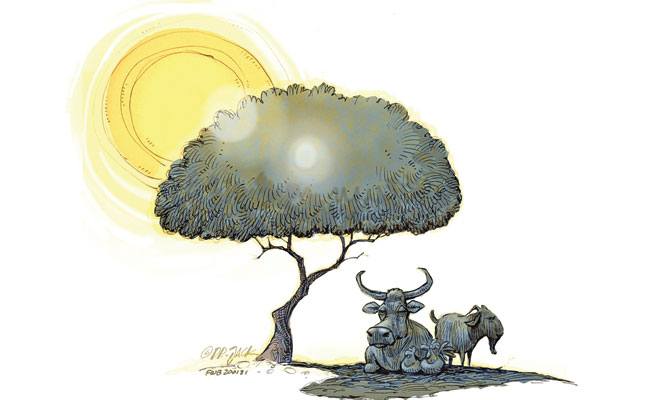
Broadly speaking, drylands are characterised by a scarcity of water. The United Nations Environment Programme defines them as lands with an aridity index (AI) of less than 0,65. (The AI is the ratio between average annual precipitation and potential evapotranspiration; if the former is less than the latter, the climate is regarded as arid.).
It further divides drylands into hyper-arid lands, arid lands, semi-arid lands and dry sub-humid lands.
Drylands cover about 41% of the Earth’s land surface, or about 6,1 billion hectares. They are distributed among all continents at tropical and temperate latitudes. Africa has the largest area of drylands (32% of the world’s total), followed by Asia, North America, Oceania, South America and Europe.
An estimated two billion people live in drylands, about 90% of them in developing countries. The majority depend on forests and other wooded lands, grasslands and trees on farms for their livelihoods and to meet basic needs for food, medicine, wood energy and non-wood forest products.
Trees tend to be integral parts of traditional food systems in drylands, because crops and livestock thrive in their presence. Their leaves and fruits are sources of food and fodder.
Trees and forests in drylands generate a wealth of environmental services; they provide habitats for biodiversity, protect against water and wind erosion and desertification, provide shade for crops and animals, help water infiltrate soil, and contribute to soil fertility.
They also increase the resilience of landscapes and communities in the face of global change. Drylands are home to 35% of global biodiversity hotspot areas, as well as one-third of all endemic and important bird areas. Drylands support half of the world’s livestock, a source of food security for the dryland population living in developing countries.
Climate change
Drylands are vulnerable to climate change, which will affect their ecosystem services and increase land degradation. According to the World Atlas of Desertification, drylands have expanded over the past 60 years and are expected to expand by 10% to 23% by the end of this century.
Life in drylands is precarious, and the socio-economic status of people in drylands is lower than that of people in many other areas. Water availability, already (on average) one-third below the threshold for minimum human well-being and sustainable development, is expected to decline further, due to changes in climate and land use.
Poor people living in areas remote from public services and markets and dependent on marginal natural resource bases will be most vulnerable to food shortages. Land degradation and desertification, combined with drought, hunger and violence, are already leading to forced migration in dryland regions in Africa and western Asia.
Dryland degradation in developing countries is estimated to cost between 4% and 8% of their GDP. Urgent action is needed to improve the management and restoration of drylands.
Southern Africa
The drylands of Southern Africa cover 224 million hectares, which is 84% of the region’s land area. Sixty percent of this is semi-arid. Forests cover 27% of the drylands in the region and other wooded land 33%, yet 47% of the dryland area has no tree cover.
About 78% of Southern Africa’s forest is found in the semi-arid zone. Forests and woodlands in the drylands in Southern Africa are an important resource on which many people depend.
They play a key part in soil and water conservation and support large numbers of livestock and game, which are crucial to food security and tourism.
Most people in Southern Africa live in areas dominated by dryland forests and many households, both rural and urban, rely on woodlands. Dryland forests provide wood and non-wood forest products that support rural and urban livelihoods, from foods (mushrooms, fruits, honey, insects and wildlife) and medicines, to fuel and building materials (poles, grass and fibre). Wood fuel remains a key source of energy.
The forest plantation sector in Southern Africa, especially in South Africa, eSwatini and Zimbabwe, is well developed, largely as it is well integrated with the processing sector and most of the plantations are privately owned and have clearly defined management objectives.
Forest and other woody vegetation are crucial for livestock production. Pastoralism occupies a large portion of Southern Africa’s drylands, including the southern part of Namibia.
Southern Africa’s dryland biodiversity is also a major draw for ecosystem conservation and ecotourism. Wildlife is a key element in tourism, particularly in protected areas.
Biodiversity hotspots in the drylands include the Succulent Karoo, along the coastal strip of southwestern Namibia and northwestern South Africa, notable for the world’s richest flora of succulent plants, with about one-third of the world’s 10 000 species.
Overall, the area of forest and woodland has been declining in the past decade. Due to low population density, the conversion rate is lower than in other parts of the world with similar vegetation.
However, desertification and land degradation, soil erosion, water scarcity, inefficient reforestation activities and the breakdown of traditional systems of conserving natural resources are expected
The views expressed in our weekly opinion piece do not necessarily reflect those of Farmer’s Weekly.
This is an edited abstract of the report, ‘Trees, forests and land use in drylands: the first global assessment’, by the Food and Agriculture Organization of the United Nations. Visit fao.org to read the full report.











